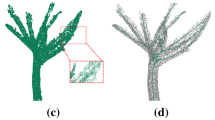Abstract
Contraction-based skeleton extraction methods have the feature that during skeleton extraction process, the correspondence between skeleton and mesh regions can be obtained, which makes this class of algorithm attractive. Besides, among all mesh skeleton extraction methods, contraction-based methods possesses the merits of robustness to noise, rotation invariant and no requirement on additional boundary conditions. However, contraction-based methods still suffer some flaws such as not promising homotopy or centeredness, or not capable of processing non-closed meshes, etc. In this paper, an improved contraction-based skeleton extraction method is proposed which covers the failure of existing methods at non-closed part of a model and increases the rationality of the centeredness correction of the skeleton: First, non-closed models are virtually closed by a preprocessing stage such that models with boundaries can be contracted in the same way as the closed ones. Second, to improve the centeredness of the skeleton, we present a simpler and more effective one-ring area sequence weighting scheme by which the displacements measuring the shift of skeleton nodes can be calculated. Experimental results show the effectiveness of our work.






Similar content being viewed by others
Explore related subjects
Discover the latest articles and news from researchers in related subjects, suggested using machine learning.References
Arcelli C, di Baja GS, Serino L (2011) Distance-driven skeletonization in voxel images. IEEE Trans Pattern Anal Mach Intell 33(4):709–720. doi:10.1109/TPAMI.2010.140
Attene M, Biasotti S, Spagnuolo M (2003) Shape understanding by contour-driven retiling. Vis Comput 19:127–138. doi:10.1007/s00371-002-0182-y
Au OKC, Tai CL, Chu HK, Cohen-Or D, Lee TY (2008) Skeleton extraction by mesh contraction. ACM Trans Graph 27(3). doi:10.1145/1360612.1360643 (ACM SIGGRAPH Conference 2008, Singapore, Singapore, 11–15 Aug 2008)
Aujay G, Hetroy F, Lazarus F, Depraz C (2007) Harmonic skeleton for realistic character animation. In: Metaxas D, Popovic J (eds) Symposium on computer animation 2007: ACM SIGGRAPH/Eurographics symposium proceedings. ACM SIGGRAPH; Eurog Assoc. Symposium on computer animation. San Diego, CA, 3–4 Aug 2007, pp 151–160
Cao J, Tagliasacchi A, Olson M, Zhang H, Su Z (2010) Point cloud skeletons via Laplacian based contraction. In: Pernot JP, Rossignac J, Spagnuolo M, Falcidieno B, Veron P (eds) Proceedings of the Shape Modeling International (SMI 2010). Shape Modeling International (SMI 2010), 21–23 June 2010. Aix-en-Provence, France, pp 187–97
Cgal Computational Geometry Algorithms Library. (1997)http://www.cgal.org. Accessed 19 Oct 2011
Cornea ND (2007) Curve-skeletons: properties, computation and applications. Ph.D. thesis, Rutgers, The State University of New Jersey
Cornea N, Silver D, Yuan X, Balasubramanian R (2005) Computing hierarchical curve-skeletons of 3D objects. Vis Comput 21(11):945–955. doi:10.1007/s00371-005-0308-0
Cornea ND, Silver D, Min P (2007) Curve-skeleton properties, applications, and algorithms. IEEE Trans Vis Comput Graph 13(3):530–548. doi:10.1109/TVCG.2007.1002
Dey TK, Sun J (2006) Defining and computing curve-skeletons with medial geodesic function. In: Geometry processing, Eurographics, SGP. Eurographics Association, Aire-la-Ville, pp 143–152
Hilaga M, Shinagawa Y, Kohmura T, Kunii T (2001) Topology matching for fully automatic similarity estimation of 3D shapes. In: SIGGRAPH 2001 conference proceedings. Computer graphics. ACM SIGGRAPH. SIGGRAPH 2001, Los Angeles, CA, 12–17 Aug 2001, pp 203–212
Ma C-M, Wan S-Y, Lee J-D (2002) Three-dimensional topology preserving reduction on the 4-subfields. IEEE Trans Pattern Anal Mach Intell 24:1594–605
Ma W-C, Wu F-C, Ouhyoung M (2003) Skeleton extraction of 3D objects with radial basis functions. In: Kim M-S (ed) Proceedings. Shape modeling international 2003, 12–15 May 2003. Seoul, South Korea, pp 207–215
Ogniewicz R, Ilg M (1992) Voronoi skeletons: theory and applications. In: Proceedings. 1992 IEEE Computer Society Conference on Computer Vision and Pattern Recognition (Cat. No.92CH3168-2). IEEE, 15–18 June 1992, Champaign, IL, USA, pp 63–69
Palagyi K, Kuba A (1999) A parallel 3D 12-subiteration thinning algorithm. GMIP 61(4):199–221. doi:10.1006/gmip.1999.0498
Pantuwong N, Sugimoto M (2010) Skeleton-growing: a vector-field-based 3d curve-skeleton extraction algorithm. In: ACM SIGGRAPH Asia 2010 sketches, SA ’10. ACM, New York, NY, pp 6:1–6:2. 10.1145/1899950.1899956
Shilane P, Min P, Kazhdan M, Funkhouser T (2004) The princeton shape benchmark. In: Shape modeling applications, 2004. Proceedings. IEEE, pp 167–178
Wang Y-S, Lee T-Y (2008) Curve-skeleton extraction using iterative least squares optimization. IEEE Trans Vis Comput Graph 14:926–36
Willcocks C, Li F (2012) Feature-varying skeletonization. Vis Comput 28:775–785. doi:10.1007/s00371-012-0688-x
Acknowledgements
We would like to thank all anonymous reviewers for their helpful comments and suggestions.This work is supported by the National Natural Science Foundation of China (61100187), the Fundamental Research Funds for the Central Universities (Grant No. HIT. NSRIF. 2010046) and the China Postdoctoral Science Foundation (2011M500666).
Author information
Authors and Affiliations
Corresponding author
Rights and permissions
About this article
Cite this article
Yu, L., Han, Q. & Niu, X. An improved contraction-based method for mesh skeleton extraction. Multimed Tools Appl 73, 1709–1722 (2014). https://doi.org/10.1007/s11042-013-1650-2
Published:
Issue Date:
DOI: https://doi.org/10.1007/s11042-013-1650-2




